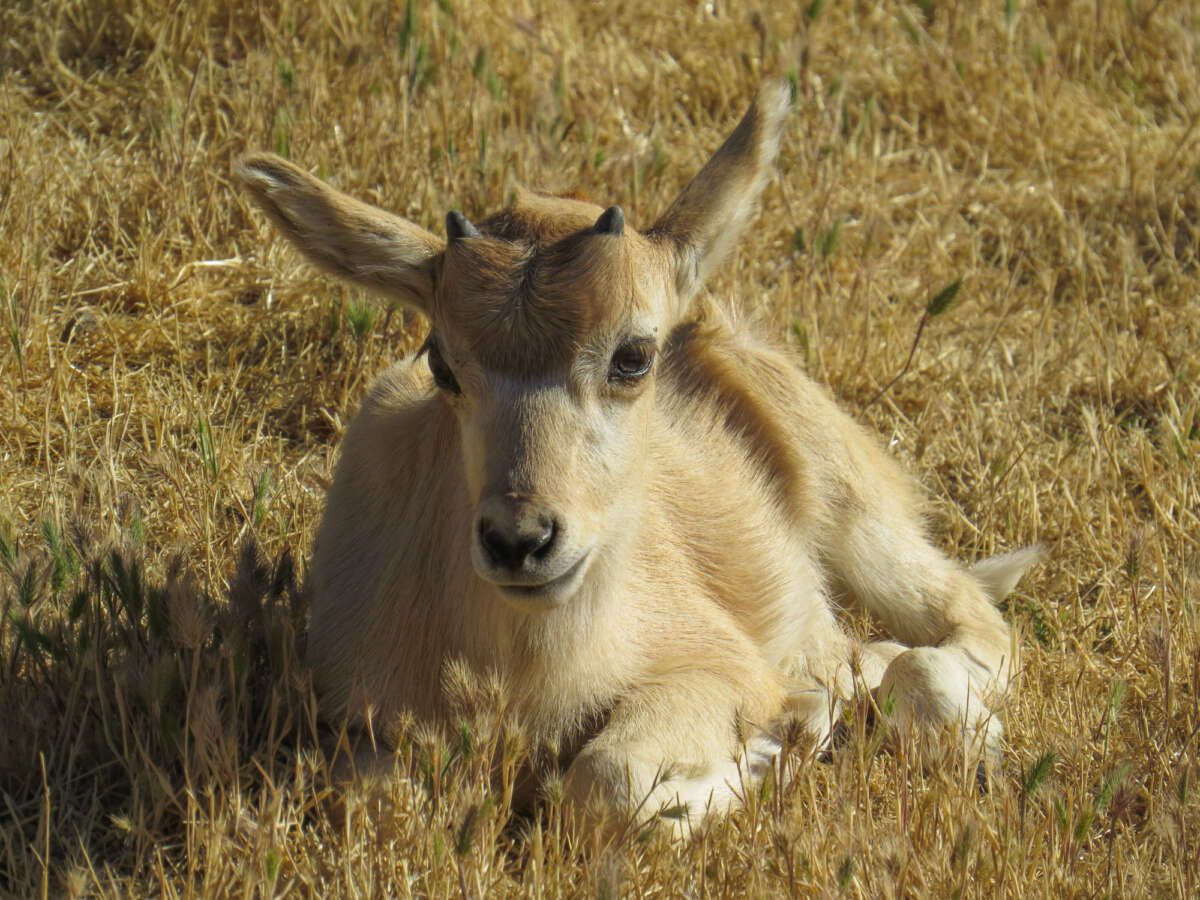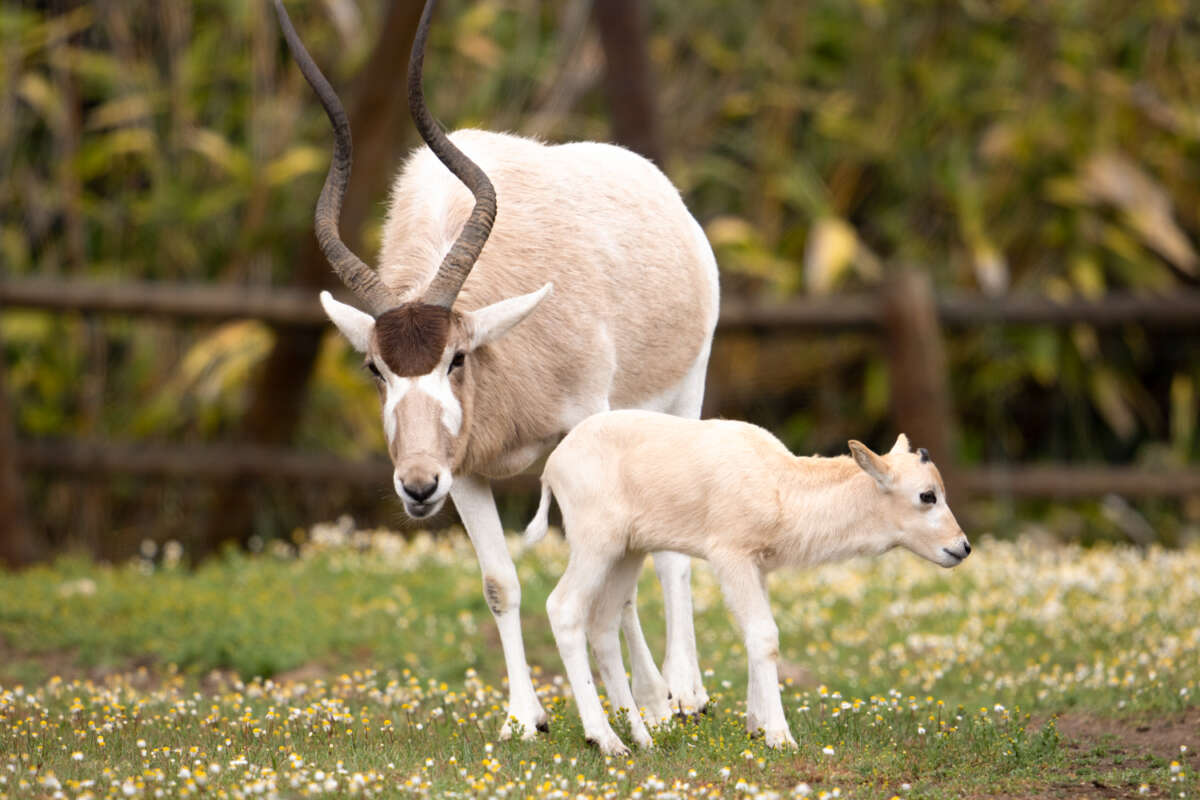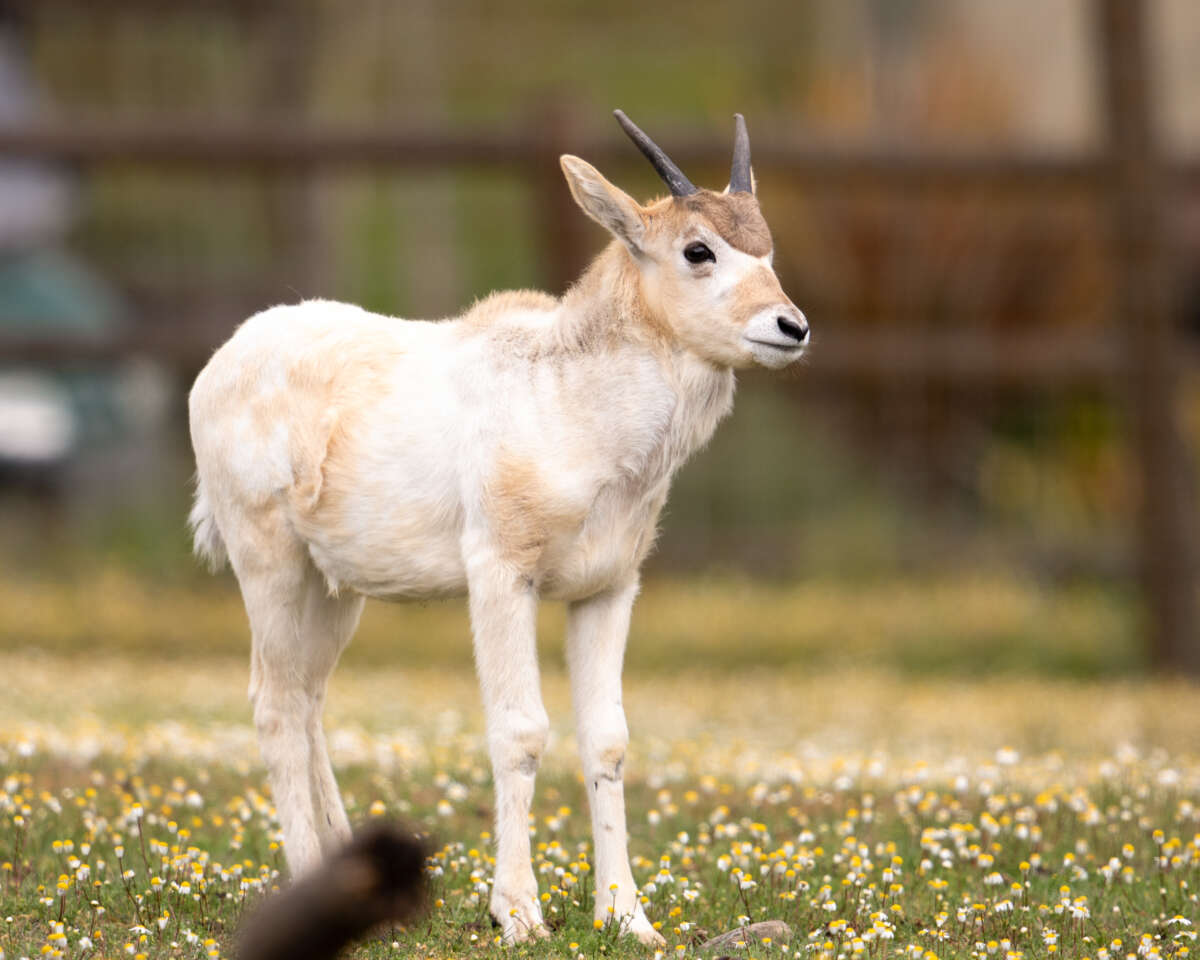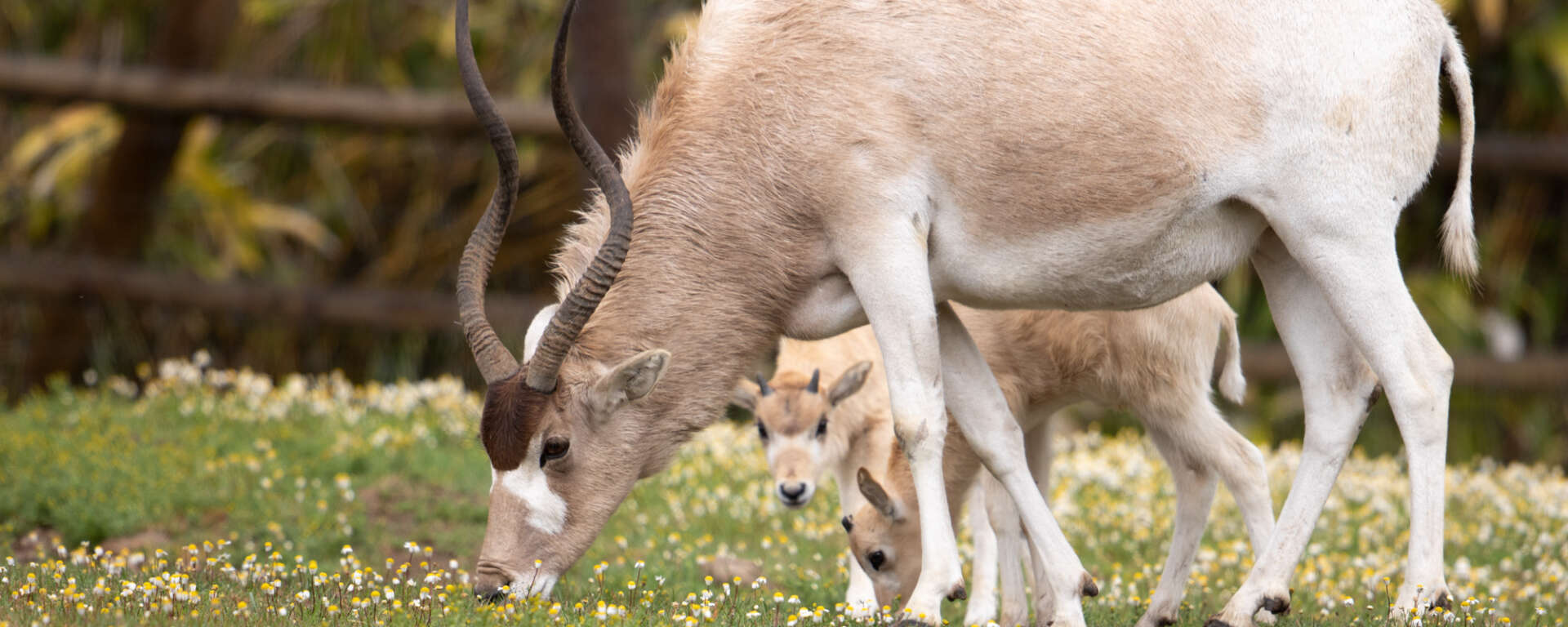Description
The addax is a sandy to white color during the summer and darkens to a shaggy brown in the winter. White markings on their face accentuate the mat of brown to black hair on their forehead. Both males and females have spiral horns, with those of the males growing longer, 2.5 – 3 ft (76 – 91 cm), than those of females, 1.5 – 2.5 ft (46 – 76 cm). Addax have widely splayed, flat hooves and prominent dewclaws which enable easy passage over the soft desert sands of the Sahara.
Cover photo: Two baby addaxes & parent by Mark Pressler
Classification
- Overview
- The addax is an antelope in the Hippotragini tribe, which are described as grazers with somewhat horse-like bodies. Other members of this tribe include the Gemsbok, Scimitar-horned Oryx, and Roan antelope.
- Class
- Mammalia
- Order
- Cetartiodactyla
- Family
- Bovidae
- Tribe
- Hippotragini
- Genus
- Addax
- Species
- A. nasomaculatus
Key Facts
- Conservation Status
- Critically Endangered
- Lifespan
- ~19 – 25 years
- Height (at shoulder)
- 3 – 3.8 ft (~95 – 115 cm)
- Weight
- 132 – 275 lb (~60 – 125 kg)
The IUCN Red List classifies the Addax as Critically Endangered, with a total population estimated at under 100 individuals across their range. The population continues to decline due to ongoing threats of hunting, habitat loss, and disturbance related to oil exploration. A thorough survey conducted by the Sahara Conservation Fund in 2015 failed to find any living addax and founds tracks and other evidence of no more than 25 individuals. A follow-up aerial survey conducted in March of 2016 was only able to find 3 addax.
There are currently ~2000 – 3000 Addax under human care across the world. Global partnerships between government agencies of Chad and Niger and an array of conservation organizations including the Sahara Conservation Fund (SCF) and the International Union for Conservation of Nature (IUCN) have resulted in a regional action plan to conserve Addax. The priorities are to prevent further loss of wild Addax by protecting key habitat areas, to assist local communities in engaging with conservation efforts, and to reintroduce groups of Addax that are under human care back into the wild.
In late 2019, the first group of 15 Addax previously under human care were reintroduced into central Chad, followed by an additional 25 Addax a few months later. Small groups of reintroductions have continued, and there is now a population of ~75 reintroduced Addax in the deserts of North Africa. In July of 2020, two reintroduced females gave birth to the first two wild-born Addax calves from this new population, giving a much needed glimmer of hope for this project and for the continued survival of this species.
Social Life
Addax are nomadic, wandering over large areas in search of plants to graze. When their population was larger, they would migrate seasonally between the Sahara and the Sahel deserts with groups of up to 1,000 animals. In recent times, most groups of Addax have been as small as 5 – 20 individuals with herds usually being led by a dominant adult male. Males attempt to establish their own territory with aggressive bouts and try to keep fertile females within these territories. Females also establish a hierarchy of dominance within the herd, with the oldest females often ranking the highest. Addax are usually active during the night as well as dawn and dusk, as the Sahara is typically too hot for daytime activity. In order to keep cool, they will dig down to the cooler underlying sand to rest.
Habitat and Range
The addax is one of the most desert-adapted large hoofed mammals, and is found in gravelly and sandy regions of the Sahara desert, with the largest population in Niger. They occur in areas of extreme high and low temperatures combined with periods of extreme drought.
Diet
Addax spend most of their lives crossing great distances in the Sahara searching out the sparse vegetation. When they encounter food they feed on desert succulents, grasses, herbs and leaves of small bushes. They are able to spend most of their lives not drinking water from a standing source, receiving enough moisture to survive from the vegetation they feed on.
Predators
Historically lions, leopards and hyenas would prey on the addax. Today most large predators are no longer present in North Africa.
Reproduction
Sexual maturity: Male: ~3 years, Female: ~1.5 years
Mating Season: Year-round
Birth Season: Birthing peaks in winter and early spring
Gestation: ~8.5 months
No. of Young: 1, very rarely 2
- Information
-
Description
The addax is a sandy to white color during the summer and darkens to a shaggy brown in the winter. White markings on their face accentuate the mat of brown to black hair on their forehead. Both males and females have spiral horns, with those of the males growing longer, 2.5 – 3 ft (76 – 91 cm), than those of females, 1.5 – 2.5 ft (46 – 76 cm). Addax have widely splayed, flat hooves and prominent dewclaws which enable easy passage over the soft desert sands of the Sahara.
Cover photo: Two baby addaxes & parent by Mark Pressler
Classification
- Overview
- The addax is an antelope in the Hippotragini tribe, which are described as grazers with somewhat horse-like bodies. Other members of this tribe include the Gemsbok, Scimitar-horned Oryx, and Roan antelope.
- Class
- Mammalia
- Order
- Cetartiodactyla
- Family
- Bovidae
- Tribe
- Hippotragini
- Genus
- Addax
- Species
- A. nasomaculatus
Key Facts
- Conservation Status
- Critically Endangered
- Lifespan
- ~19 – 25 years
- Height (at shoulder)
- 3 – 3.8 ft (~95 – 115 cm)
- Weight
- 132 – 275 lb (~60 – 125 kg)
- Conservation
The IUCN Red List classifies the Addax as Critically Endangered, with a total population estimated at under 100 individuals across their range. The population continues to decline due to ongoing threats of hunting, habitat loss, and disturbance related to oil exploration. A thorough survey conducted by the Sahara Conservation Fund in 2015 failed to find any living addax and founds tracks and other evidence of no more than 25 individuals. A follow-up aerial survey conducted in March of 2016 was only able to find 3 addax.
There are currently ~2000 – 3000 Addax under human care across the world. Global partnerships between government agencies of Chad and Niger and an array of conservation organizations including the Sahara Conservation Fund (SCF) and the International Union for Conservation of Nature (IUCN) have resulted in a regional action plan to conserve Addax. The priorities are to prevent further loss of wild Addax by protecting key habitat areas, to assist local communities in engaging with conservation efforts, and to reintroduce groups of Addax that are under human care back into the wild.
In late 2019, the first group of 15 Addax previously under human care were reintroduced into central Chad, followed by an additional 25 Addax a few months later. Small groups of reintroductions have continued, and there is now a population of ~75 reintroduced Addax in the deserts of North Africa. In July of 2020, two reintroduced females gave birth to the first two wild-born Addax calves from this new population, giving a much needed glimmer of hope for this project and for the continued survival of this species.
- Lifestyle
Social Life
Addax are nomadic, wandering over large areas in search of plants to graze. When their population was larger, they would migrate seasonally between the Sahara and the Sahel deserts with groups of up to 1,000 animals. In recent times, most groups of Addax have been as small as 5 – 20 individuals with herds usually being led by a dominant adult male. Males attempt to establish their own territory with aggressive bouts and try to keep fertile females within these territories. Females also establish a hierarchy of dominance within the herd, with the oldest females often ranking the highest. Addax are usually active during the night as well as dawn and dusk, as the Sahara is typically too hot for daytime activity. In order to keep cool, they will dig down to the cooler underlying sand to rest.Habitat and Range
The addax is one of the most desert-adapted large hoofed mammals, and is found in gravelly and sandy regions of the Sahara desert, with the largest population in Niger. They occur in areas of extreme high and low temperatures combined with periods of extreme drought.Diet
Addax spend most of their lives crossing great distances in the Sahara searching out the sparse vegetation. When they encounter food they feed on desert succulents, grasses, herbs and leaves of small bushes. They are able to spend most of their lives not drinking water from a standing source, receiving enough moisture to survive from the vegetation they feed on.Predators
Historically lions, leopards and hyenas would prey on the addax. Today most large predators are no longer present in North Africa.Reproduction
Sexual maturity: Male: ~3 years, Female: ~1.5 years
Mating Season: Year-round
Birth Season: Birthing peaks in winter and early spring
Gestation: ~8.5 months
No. of Young: 1, very rarely 2

Baby addax by Mark Pressler

Baby addax & parent by Mark Pressler

Juvenile addax by Mark Pressler

